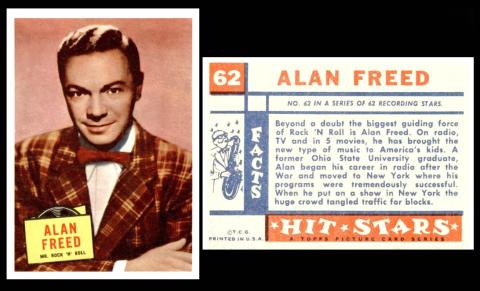
Here we have one of the non-singers that were inducted into the Hall of Fame in the first wave. This is Albert James Alan Freed, the disc jockey who gave the phrase "Rock and Roll" to the World almost by accident.
He was born on December 15th, 1921, in Johnstown Pennsylvania. He played trombone, in a band, though his dream was to be a bandleader. Sadly he had recurring ear problems, and this resulted in an infection which affected his hearing. Instead, he went to University, and started to become interested in the possibilities of radio as entertainment, not just information. During the Second World War he was asked if he would do a spot of presenting on Armed Forces Radio. This was more like his dream of radio, rousing tunes to entertain the soldiers as they prepared to go into battle and soft tunes to remind them of home in their downtime.
After he was demobbed, he started hunting for radio presenting jobs, picking up several such gigs in Pennsylvania and Ohio. He also changed the playlists, introducing more of the rousing tunes, like jazz, blues, and pop, and using recordings by the original African American singers, not the cover versions by white singers that radio habitually used.
He started to call this mixed style "Rock and Roll", and the teenagers, themselves newly invented, rebelling against the old ways, and wanting change, could not get enough.They said he talked their language, and he did.
However there is another reason for his inclusion in the Rock and Roll Hall of Fame, and that is an event he organized, in Cleveland, which is considered the first ever Rock and Roll concert. This was called "The Moondog Coronation Ball", and so many listeners attended that there was gross overcrowding, and also, almost, a riot amongst those who could not get in. This hit the papers, and raised his profile, and led to him appearing in several cinema films produced to please the teenage audience, including "Rock around the Clock" and "Mister Rock and Roll", which he adopted as a nickname.
He also gained a weekly music series, in 1957, "The Big Beat", which fell foul of the segregation laws of the time, and was cancelled. He ran into other trouble after that, being accused of taking too much of a cut of the money, and even claiming the writing credits falsely, from the artists he represented. He was also hit with massive tax bills. He started to drink more, and died in January 1965 at the age of just forty-three.
Now I thought we had featured this set before, but we have not, that one, which you can see in our newsletter for https://csgb.co.uk/publications/newsletter/2023-02-04 was Topps "Hit Stars" too but if you look in the bar beneath the star`s name, it says "A Series of 37 T.V. and Movie Stars", whereas our card says "A Series of 62 Recording Stars". After investigation the set is actually comprised of eighty-eight cards, It turns out to be a set of 88 cards, with card 63 being card 1 of the movie star set. But it is useful to clear this up. Though the numbering is baffling as the last card, 88, says it is number 26 in the series of 37. Maybe someone with a complete set, and a better head for math, can sort this out for us? Many thanks in advance.
